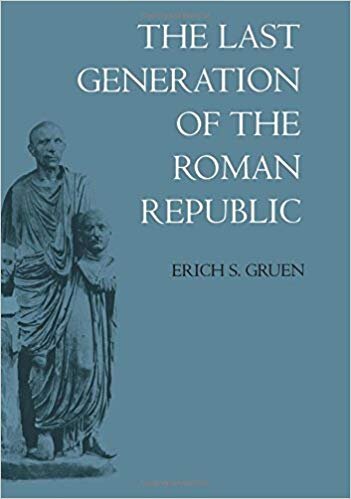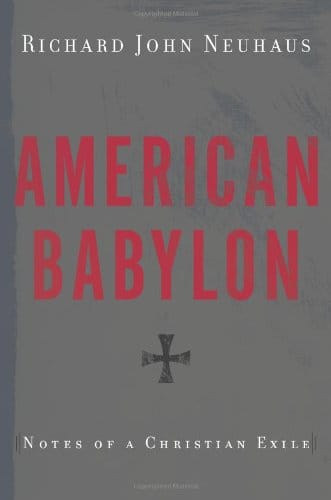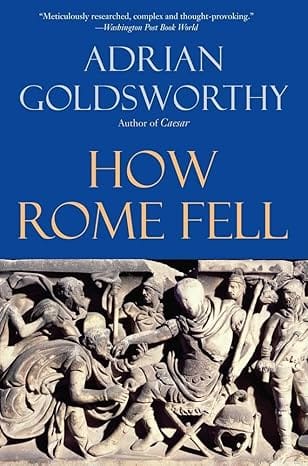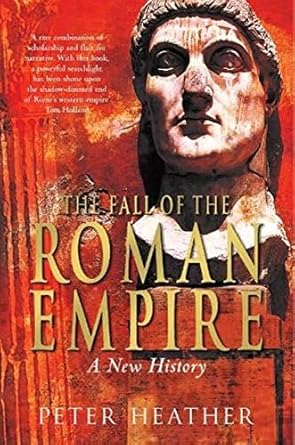The Long View: The Last Generation of the Roman Republic By Erich S. Gruen
Like John J. Reilly, I too am fond of making allusions to the late Roman Republic and comparing it to the present, but this book review also makes the excellent point that you shouldn’t try to map politics of the present too closely onto the past. What goes by the name populism now isn’t really the same thing the Romans meant by Populares, although there might be said to be a family resemblance.
Some choice quotes:
"the people," for revolutionary purposes, consists precisely of the able but frustrated, and not of the street canaille who might be called out for the final act?
…
Finally, one might question how strong the argument against hindsight really is. In a statistical context, Bayes's Rule allows us to reduce the uncertainty of our knowledge about an earlier situation by using later information. In a historical context, when all Hell breaks loose, we may often properly infer that it has been trying to escape for some time.
Up next, a contrasting book by the more recent historian Tom Holland [but not Spiderman] that addresses the same events, but written 40 years later.

The Last Generation of the Roman Republic
By Erich S. Gruen
University of California Press, 1974 (Paper 1994)
596 Pages, US$30.00
ISBN: 0-520-20153-1
The 1970s were a regrettable decade in many ways. One of the characteristic intellectual deformations of the time was a suspicion of all received historical narratives; and indeed, in the frigid first circle of the deconstructionist academy, of narrative itself. This essentially literary prejudice manifested in some of the oddest places. Stephen Jay Gould, for instance, one of the great figures in the field of paleontology, ensured that his reputation would be diminished in later years because of his polemical and insupportable insistence that the history of life is a directionless accumulation of frozen accidents. The greatest damage, however, was in historical studies, and not least in the study of the classical Greco-Roman world. To this day, you can find professors at the end of their careers (or already in the emeritus afterlife) repeating that the “fall of the Rome” is a later historiographical construct, a construct that dismisses the vibrancy and creativity of the Mediterranean world in the fifth century.
The Last Generation of the Roman Republic [Amazon link], published in 1974 by a noted classical historian at the University of California at Berkeley, attempted a comparable revision of received opinion about the end of the Roman Republic and the beginning of the Empire. Yes, we are told, the Republic did end in the string of civil wars that began in the 40s of the last century before Christ, but that end was purely a matter of chance. There was no "roman revolution" (to echo Ronald Syme’s famous book of that name), and there was no lethal dysfunction within the Roman polity. What happened was a series of elite conflicts and accommodations within the context of the remarkably resilient constitution that the conservative reformer Sulla had imposed on the Republic after his defeat of the followers of the popularis Marius. The elections, political indictments, and occasional acts of mob violence from the death of Sulla in 78 BC to Caesar’s decision to cross the Rubicon in 49 BC were dramatic and dangerous for those involved, but they were conducted in ways and for purposes there were familiar in Roman history. No one was trying to overthrow the state: not Caesar or Pompey at the last hour in 49, not Clodius the demagogue in the 50s, not Catiline the conspirator at the end of the 60s; not even Spartacus in the 70s (Spartacus and his people did not want a social revolution; all they wanted was to leave Italy). The conflict between Caesar and Pompey was the beginning of the end of the Republic because it started what was, in effect, a world war that lasted almost 20 years. By the end of it, the continuity of Roman political practice was broken and there was no way to revive it.
Reading this book is an enlarging exercise. There are long stretches of stentorian exposition that would do credit to a Victorian historian, interspersed with even longer stretches of the sort of pointillist analysis of sources that only classicists and Supreme Court justices seem to be able to get away with. Hardcore classicists don’t need to be told the difference between M. Cicero and Q. Cicero. They could explain at the drop of a hat what a prosecution de ambitu might be, if they felt it to be any part of their office to enlighten the ignorant. To be fair, such matters in this book are explained, eventually. Also, for this paperback reprint on the 20th anniversary of the book’s first publication, the author wrote a preface describing the reception of the work and the criticisms that have been made of it.
There are many points about which the author is clearly correct. It is a mistake to conflate Roman political factions with modern political parties. Political organization was a very personal affair, a matter of alliances and treasured antipathies between individuals and extended families that might last for generations. The term Optimates was not the name of a political organization; it was a neutral term for the most distinguished citizens. Neither was there such a thing as a "Senatorial Party": all the major figures of the later Republic were members of the Senatorial Order (meaning they had been elected to one of the municipal offices at some point and consequently had a vote in the Senate). This was as true of the Populares as anyone else, if not more so. The urban and rural proletariat were connected to the political system as clients of members of the Senatorial Order, not through horizontal political entities of their own.
The author might usefully have taken these thoughts further in at least one direction. One could argue that the advent of eschatological Marxism into the political theory of the later West, with its notions of proletarian triumphalism and social transformation, actually impaired our ability to perceive the popular politics of the classical world (as well as, it now seems, the genuine popular politics of our own). The Spartacus revolutionaries of Weimar Germany took the name of an ancient rebel for inspiration, but took nothing of the spirit of their hero, or even of the murmuring (and sometimes rock-throwing) urban proletariat of his era.
Unfortunately, the author uses these insights less helpfully. We get a thorough (though still somewhat speculative) assessment of the social origins of the successful candidates for electoral office in Rome over the generation in question. The author concludes that the people continued to elect candidates whose family antecedents had served in those offices previously, often for several centuries. Indeed, we are given to understand that Roman electoral politicians did not have platforms. Rather, they displayed the busts of their fathers and grandfathers to electors whose own fathers and grandfathers had voted for them. They also dispersed bribes to their supporters and dispatched gangs to dissuade voting by the less supportive, but those activities had a fine old history, too.
Only in the second half of the book does the author get around to mentioning the promises that populists like Catiline or Caesar might make to their supporters, or of Clodius’s ability to wield a rabble as part of the legislative process (quite a lot of which, by the way, had to go through the popular assemblies). Roman politicians of a populist bent did not promise their supporters heaven on earth, but they did promise an immediate and substantial improvement in their condition. They might promise a distribution of land, or expanded rights to free grain, or remission of debts. They might also promise that these good things would be paid for out of the pockets of their factional opponents. It is not really surprising that Roman electors favored familiar names and faces: that is always true of electoral politics. Once the candidates were in office (and membership in the Senate was for life, barring expulsion) Roman politicians did have platforms and political organizations. Indeed, it is hard to see how the durable group of conservative intellectuals and statesmen that we associate with names like Cato and Hortensius can be considered anything other than a party; not "The Senatorial Party," perhaps, but a party in the Senate.
Similarly with the author’s argument that there was no class war in the broad sense in the late Republic. The author instructs us usefully in the limited political ambitions of the urban plebs. They might make displays of violence to get some welfare benefit; often they would succeed. However, they had no interest in bringing down the state, since the state to them meant their own patrons and paymasters. Thus, the author assures us, when contemporaries of these events, such as Sallust, tell us the final generation of the free state was wracked by conflict between high and low, they are engaging in simplifying rhetoric. Nonetheless, elsewhere the author mentions that Caesar favored entrepreneurial "new men," provincials, and recently enfranchised Italians for his officers and younger colleagues, whereas Pompey looked to the scions of old families who had been in the Senate as long as anyone could remember. Could the author really not know that "the people," for revolutionary purposes, consists precisely of the able but frustrated, and not of the street canaille who might be called out for the final act?
The author does not really think that there were no trends in the political history of the late Republic. Here he says, chiefly in answer to the charge that the post-Sullan Senate was lazy or inattentive:
Through it all, the bulk itself of the legislative activity stands out. That fact is impressive, but disturbing. It may be that it proved more damaging than advantageous. Rome had not needed such activity in the past. The mos maiorum had sufficed; express regulations could be kept to a minimum. But the period that ran from the Gracchi to Sulla undermined confidence in established traditions. Sulla sought to restore confidence. But in so doing he adopted the premises of the Gracchi themselves: that desired ends are best enforced by overt legislation. The generation that followed Sulla accepted that principle. The aim of securing and preventing infractions issued in a stream of new leges. The movement edged toward a firmer structure, but the result allowed less freedom for maneuver. A more informal but more secure age in the past could absorb change and overlook abuse without severely shaking the system. But when malleable traditions were hardened into laws, even minor offenses had to be regarded as illegal violations. The consequence was a mania for fashioning and refining statutes, and a mounting succession of judicial prosecutions. The direction of post-Sullan society moved from flexible institutions toward strictly defined practices. The structure was tighter but more brittle. Roman statesmen were, on the whole, sincere and assiduous in attacking contemporary problems. But the means employed, a proliferation of statutory law, may have contributed to the Republic’s undoing.
There is something to this, in the sense that the new legislation about the conduct of elections, the administration of provinces, and even the clarity of the criminal law showed that the rhythm of Roman political culture was not what it had been. The author does a good job of recounting how figures best known to history as fire-breathing rabble-rousers in fact were responsible for much sober and necessary legislation; legislation that, moreover, was enacted by the consensus of the main political factions. The problem with this formulation is that the history of the final generation of the Republic (of the final three generations, actually, since the author averts back to the Gracchi) simply is not a tale of a society becoming more orderly but less flexible.
The "flexibility" of the Sullan constitution is actually one of the author’s key themes. During the 70s, in the years immediately following Sulla’s death, most of the peculiar features of his scheme of government were repealed. Sulla had allowed only senators to serve on juries; soon wealthy citizens ("equites" or "knights") could do so again, too. The tribunes were returned to their former authority and numbers in the Senate. These repeals had usually been taken as evidence that the political settlement that Sulla imposed was ephemeral; the author says that they prove that Sulla’s constitution was so durable that it could tolerate necessary reform.
The 60s were dominated by the growing prestige of Pompey the Great, who proved to be the greatest conqueror in the eastern Mediterranean since Alexander. Julius Caesar was originally just another ambitious young man in his entourage. While Pompey was subduing the eastern pirates and finally ending the threat to the Republic’s hegemony from Mithridates, he was, of course, being indirectly attacked by enemies in Rome, chiefly in the form of politically motivated prosecutions of Pompey’s known friends and supporters. The author notes that the point of these trials was not to obtain a conviction (that did happen now and again, almost by oversight), but to demonstrate that a great patron could not protect his clients, and to keep disparaging rumors about the patron in circulation, particularly if he was too far away to answer them. It is significant that the author calls his whole period the Age of Cicero. Cicero was in fact an important senatorial politician (and, as he would remind everyone he met until his death in 43, the consul who unmasked and suppressed the attempted coup by Catiline), but he bulks large in the historical record because he acted as defense counsel in just about all the important trials and many of the minor ones. We remember him because his orations to the court provide capsule histories of the events of his time.
Political trials may be all good fun, and the trials of the 60s may have been only an exaggeration of earlier practice. It’s hard to make a similar argument about the 50s, the decade of the First Triumvirate. That was an unofficial but potent alliance among Pompey, back from the East and not inclined to take any more guff, plus Caesar, and Crassus. The last is often identified as a "financier," but one of the author’s revisionist notions is that it is a mistake to dismiss him just as “Senator Money Bags.” On the other hand, the author is also disinclined to accept the traditional assessment that Crassus made himself useful by preventing Pompey and Caesar from coming to blows, since the author claims that Pompey and Caesar never really intended to come to blows.
In any case, the Triumvirate could rig elections through force and rescheduling when they had a mind to, particularly when one of its own members stood for office, but not infallibly. In 53, both consuls, the Republic’s chief executives, were killed by mobs, the Senate House was burned, and there was no executive to organize new elections. (To make the story perfect, Senator Money Bags was killed at about the same time during his ill-fated Parthian campaign.) In 52 the Senate, uniquely in the history of the Republic, named Pompey sole consul to manage the emergency. It’s not just the fact of a single executive that was anomalous, but also that the consuls were supposed to be elected by the people, not the Senate. Pompey served only the year for which he had been appointed. He was then given proconsular authority over various provinces, which in ordinary practice would have required him to visit his provinces. However, he remained in Rome, ruling his province by legates, for all the world like the Emperor Augustus a few decades later.
The author assures us that these events were further examples of the flexibility of the Sullan constitution.
The account we get of the outbreak of the civil war is actually very interesting. While all this commotion was going on in Rome, Caesar was conquering Gaul, a process that gave him both great popularity and lots of gold to keep his reputation bright among the electorate. The traditional historiography has it that war was forced on Caesar because Pompey, in connivance with a fearful and jealous Senate, had reneged on the deal among the Triumvirs whereby Caesar would relinquish his army and return to Rome as a consul; the point of the consulate for Caesar was not so much the glory as the fact that consuls were immune to prosecution. Caesar was not willing to take the risk of arrest and humiliating trial before a court his enemies might control.
The author will have none of it, however. Surely someone with Caesar’s political acumen could have weathered a trial, even if one occurred, which was by no means certain. As for the next consular election, how could Caesar not win? The author lays all the blame on a curious little tribune named Curio, who egged on both sides about the terms under which Caesar might stand for election in absentia. The clock just ran out on Caesar’s commission to Gaul, so he had to return to Rome in some capacity. At that point, neither Pompey nor Caesar could back down without injuring his dignity. So you see, the civil war was an accident of wounded pride.
But why not go further? Civil war was not a novelty in Roman history. Caesar and Pompey observed as many precedents as they broke. Why not say that the civil war was simply another exercise of the flexibility that characterized the post-Sullan state? When it was all over, remember, Augustus was claiming to have restored the Republic. His position can be defended. In recent decades, no doubt, someone has.
The author’s continuous refrain is that we must not judge the health of the late Republic in light of later events. No one knew that Caesar would become dictator: not even Caesar himself, and certainly no one anticipated the length and destructiveness of the civil war that began in 49. We can agree with this in principle. It is necessary for historians to take care not to project their own knowledge of later events onto the people they are studying; what seems obvious to the future was not necessarily obvious to the past. The problem with the author’s application of this eminently reasonable principle is that he is quick to dismiss as "hindsight" not just the analyses of Mommsen and the modern classicists, or even of Suetonius and Plutarch, but even of Cicero and Sallust, who lived in the period in question.
Finally, one might question how strong the argument against hindsight really is. In a statistical context, Bayes's Rule allows us to reduce the uncertainty of our knowledge about an earlier situation by using later information. In a historical context, when all Hell breaks loose, we may often properly infer that it has been trying to escape for some time.
For a more conventional (and probably more accurate) view of the late Republic, see Tom Holland's Rubicon.
Copyright © 2007 by John J. Reilly
Support the Long View re-posting project by downloading Brave browser. With Both Hands is a verified Brave publisher, you can leave me a tip too!



Comments ()